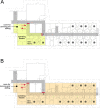Preparing for patients with high-consequence infectious diseases: Example of a high-level isolation unit
- PMID: 35239726
- PMCID: PMC8893674
- DOI: 10.1371/journal.pone.0264644
Preparing for patients with high-consequence infectious diseases: Example of a high-level isolation unit
Abstract
Introduction: Patients with high-consequence infectious diseases (HCID) are rare in Western Europe. However, high-level isolation units (HLIU) must always be prepared for patient admission. Case fatality rates of HCID can be reduced by providing optimal intensive care management. We here describe a single centre's preparation, its embedding in the national context and the challenges we faced during the severe acute respiratory syndrome coronavirus type 2 (SARS-CoV-2) pandemic.
Methods: Ten team leaders organize monthly whole day trainings for a team of doctors and nurses from the HLIU focusing on intensive care medicine. Impact and relevance of training are assessed by a questionnaire and a perception survey, respectively. Furthermore, yearly exercises with several partner institutions are performed to cover different real-life scenarios. Exercises are evaluated by internal and external observers. Both training sessions and exercises are accompanied by intense feedback.
Results: From May 2017 monthly training sessions were held with a two-month and a seven-month break due to the first and second wave of the SARS-CoV-2 pandemic, respectively. Agreement with the statements of the questionnaire was higher after training compared to before training indicating a positive effect of training sessions on competence. Participants rated joint trainings for nurses and doctors at regular intervals as important. Numerous issues with potential for improvement were identified during post processing of exercises. Action plans for their improvement were drafted and as of now mostly implemented. The network of the permanent working group of competence and treatment centres for HCID (Ständiger Arbeitskreis der Kompetenz- und Behandlungszentren für Krankheiten durch hochpathogene Erreger (STAKOB)) at the Robert Koch-Institute (RKI) was strengthened throughout the SARS-CoV-2 pandemic.
Discussion: Adequate preparation for the admission of patients with HCID is challenging. We show that joint regular trainings of doctors and nurses are appreciated and that training sessions may improve perceived skills. We also show that real-life scenario exercises may reveal additional deficits, which cannot be easily disclosed in training sessions. Although the SARS-CoV-2 pandemic interfered with our activities the enhanced cooperation among German HLIU during the pandemic ensured constant readiness for the admission of HCID patients to our or to collaborating HLIU. This is a single centre's experience, which may not be generalized to other centres. However, we believe that our work may address aspects that should be considered when preparing a unit for the admission of patients with HCID. These may then be adapted to the local situations.
Conflict of interest statement
The authors have declared that no competing interests exist.
Figures


References
-
- Gottschalk R, Grunewald T, Biederbick W. [The goals and structure of the Permanent Working Group of Medical Competence and Treatment Centers for highly contagious, life-threatening diseases]. Bundesgesundheitsblatt Gesundheitsforschung Gesundheitsschutz. 2009;52(2):214–8. doi: 10.1007/s00103-009-0766-z - DOI - PMC - PubMed
Publication types
MeSH terms
LinkOut - more resources
Full Text Sources
Medical
Miscellaneous

